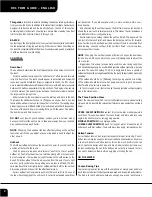
Section P
Page 3
378 Vista™ Owner’s Manual
™
378
NOTICE
To prevent gouges, uneven areas, or other dam-
age from occurring, DO NOT use a power or
belt sander when sanding. For best results,
block sand the gel coat.
C. Stains
Stains can appear anywhere on the exterior of the boat
and may be a result of contact with tar, plant sap, leaves,
rust from metal fittings, and other materials. Surface
stains may be removed with hand dish washing soap,
mild cleansers, or some household detergents. DO NOT
use chlorine or ammonia products. These products can
affect the color of gel coat. Commercial car washes use
strong cleaners and should be avoided.
To remove stains, refer to the procedures below.
1.
Wash area with hand dish washing soap.
2.
Begin with a small area such as three feet by three
feet and apply a mild cleanser.
3.
Rinse with clean water.
4.
Follow with compound and waxing as outlined in pro-
cedure above.
If the stain is not removed by the hand dish washing
soap or mild cleanser, then the next procedure is to use
either denatured or rubbing alcohol. If this does not work,
consult your Four Winns dealer for professional assis-
tance.
NOTICE
DO NOT use acetone, ketone, or other solvents
to remove stains. These chemicals are flam-
mable and may damage the gel coat.
P - 5
FIBERGLASS REPAIRS
Fiberglass is one of the most durable, strong, and for-
giving construction materials afloat. It is resilient and
normal repairs can be made without affecting the strength
or structural integrity of the boat.
Yellowing is gel coat which has a yellow cast and strea-
king usually deals with a stain or contact with another
surface.
Gloss refers to the shine of the surface. This can change
from sanding action, chalk, residues, or exposure.
Blistering refers to a condition in which the unprotected
gel coat surface below the waterline has absorbed wa-
ter and formed bubbles. See Section P-5 for additional
information.
Follow the instructions below for boats that have weath-
ered and chalked.
1.
Wash.
2.
Wax. If this does not work, then use a fine rubbing
compound. If this does not work use 400 or 600 wet
or dry sandpaper, followed by fine rubbing compound
and wax.
When using wax or fine rubbing compounds, make sure
to read the label and follow the directions. Some helpful
tips are listed below.
1.
Avoid working in direct sunlight. This dries out the
wax or compound, and can stain the surface.
2.
Use clean pads or cloths to apply a thin coating of
wax or rubbing compound to a small area such as
three feet by three feet. Remove any excess, and
then rub the area with a buffing pad, or power buffer.
Apply pressure only as necessary to restore the sur-
face finish. Applying too much pressure or buffing
in one place too long can permanently damage the
surface.
3.
After applying compound, always follow with wax-
ing.
NOTICE
If using a power buffer, use a low RPM buffer
with light pressure. Keep the pad wet and the
buffer moving at all times to prevent heat buildup.
Summary of Contents for 378 VISTA
Page 1: ...378 VISTA OWNERS MANUAL ...
Page 51: ...Section C Page 7 378 Vista Owner s Manual 378 Figure C5 Navigational Aids Chart ...
Page 73: ...Section G Page6 378 Vista Owner s Manual 378 Figure G6 Tie Bar 47 1 4 Tiller Arm Assembly ...
Page 166: ...Locator Drawing Page 1 378 378 VISTA LOCATOR DRAWING 378 Vista Owner s Manual ...
Page 196: ... Page 30 CLARION AMPLIFIER APX400 4M CONNECTIONS SETTINGS Electrical Schematics ...
Page 199: ......
Page 200: ......
Page 201: ...A G E N M A R C O M P A N Y P A R T 0 9 0 2 7 4 4 ...














































